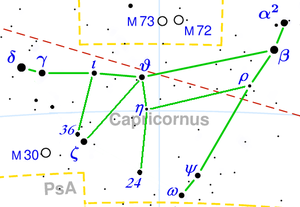Capricornus
| Constellation | |
 | |
| Abbreviation | Cap |
|---|---|
| Genitive | Capricorni |
| Pronunciation | /ˌkæprɨˈkɔrnəs/, genitive /ˌkæprɨˈkɔrnaɪ/ |
| Symbolism | the Sea Goat |
| Right ascension | 21 |
| Declination | −20 |
| Quadrant | SQ4 |
| Area | 414 sq. deg. (40th) |
| Main stars | 9, 13 |
| Bayer/Flamsteed stars | 49 |
| Stars with planets | 3 |
| Stars brighter than 3.00m | 1 |
| Stars within 10.00 pc (32.62 ly) | 3 |
| Brightest star | δ Cap (Deneb Algedi) (2.85m) |
| Messier objects | 1 |
| Meteor showers | Alpha Capricornids Chi Capricornids Sigma Capricornids Tau Capricornids Capricorniden-Sagittariids |
| Bordering constellations | Aquarius Aquila Sagittarius Microscopium Piscis Austrinus |
| Visible at latitudes between +60° and −90°. Best visible at 21:00 (9 p.m.) during the month of September. | |
Capricornus is one of the constellations of the zodiac. It is often called Capricorn, especially when referring to the corresponding astrological sign. Its name is Latin for "horned male goat" or "goat horn", and it is commonly represented in the form of a sea-goat: a mythical creature that is half goat, half fish. Its symbol is ![]() (Unicode ♑).
(Unicode ♑).
Capricornus is one of the 88 modern constellations, and was also one of the 48 constellations listed by the 2nd century astronomer Ptolemy. Under its modern boundaries it is bordered by Aquila, Sagittarius, Microscopium, Piscis Austrinus and Aquarius. The constellation is in an area of sky called the Sea or Water, consisting of many water-related constellations such as Aquarius, Pisces and Eridanus.
Notable features
[change | change source]
Capricornus is the second faintest constellation in the zodiac after Cancer. Its brighter stars are on a triangle whose corners are α2 Capricorni (also known as Giedi), δ Capricorni (Deneb Algiedi), and ω Capricorni.
Deep sky objects
[change | change source]Capricorn has several galaxies and clusters. Messier 30 is a globular cluster that is one degree south of the galaxy group NGC 7103. The constellation also harbors the wide spiral galaxy NGC 6907.
Named stars
[change | change source]| Bayer | Name | Origin | Meaning |
|---|---|---|---|
| α | Algiedi | Arabic | goat |
| α¹ | Prima Giedi | ||
| α² | Secunda Giedi | ||
| β | Dabih | Arabic | The butcher |
| β¹ | Dabih Major | ||
| β² | Dabih Minor | ||
| γ | Nashira | Arabic | Bringer of news |
| δ | Deneb Algiedi | Arabic | goat's tail |
| ζ | Yen | Chinese | |
| η | Chow | Chinese | |
| ν | Al Shat | Arabic | the sheep |
| ψ | Yue | Chinese | battle ax |
History
[change | change source]Despite it being very faint, Capricornus has one of the oldest mythological associations. It has consistently been represented as a cross of a goat and a fish since the Middle Bronze Age. The earliest picture of Capricornus is on a cylinder-seal dating c. 21st century BCE,.[1] From the mid second Millennium it became a popular motif on boundary stones.[2] It was explicitly recorded in the Babylonian star catalogues as MULSUḪUR.MAŠ "The Goat-Fish" before 1000 BC. The constellation was a symbol of Ea and in the Early Bronze Age marked the winter solstice.[3]
Because of the precession of the equinoxes the December solstice no longer takes place while the sun is in the constellation Capricornus. The astrological sign called Capricorn now begins with the solstice. The sun's most southerly position is now called the Tropic of Capricorn. This term also applies to the line on earth where the sun is directly overhead at noon on that solstice.
The planet Neptune was discovered in this constellation by German astronomer Johann Galle, near Deneb Algedi (δ Capricorni) on September 23, 1846, which is reasonable as Capricornus can be seen best at 4:00am in September.
In Chinese astronomy, constellation Capricornus is in The Black Tortoise of the North (北方玄武, Běi Fāng Xuán Wǔ).
Mythology
[change | change source]Capricorn the sea goat was a goat that decided to take over the world. The gods of Greece looked down upon that and sent there wrath and killed him with one of Zeus thunderbolts. Then they hung him in the sky to humiliate him.
Astrology
[change | change source]As of 2002, the Sun appears in the constellation Capricornus from January 19 to February 15. In tropical astrology, the Sun is considered to be in the sign Capricorn from December 22 to January 19, and in sidereal astrology, from January 15 to February 15.

Visualizations
[change | change source]
Ptolemy's method of connecting the stars of Capricornus has been influential.[4]
H. A. Rey has suggested an alternative way to join the stars, which graphically shows a goat.[5] The goat's head is formed by the triangle of stars ι Cap, θ Cap, and ζ Cap. The goat's horn sticks out with stars γ Cap and δ Cap. Star δ Cap, at the tip of the horn, is of the third magnitude. The goat's tail consists of stars β Cap and α2 Cap: star β Cap being of the third magnitude. The goat's hind foot consists of stars ψ Cap and ω Cap. Both of these stars are of the fourth magnitude.
Capricornus as the name
[change | change source]USS Capricornus (AKA-57) is once of United States navy ship.
Citations
[change | change source]- ↑ Master's Thesis of Peeter Espak, 2006 page 104 "[1]"
- ↑ Babylonian Star-lore by Gavin White, Solaria Pubs, 2008. Page 118ff
- ↑ John H. Rogers, "Origins of the ancient contellations: I. The Mesopotamian traditions", Journal of the British Astronomical Association 108 (1998) 9–28
- ↑ "Capricornus".
- ↑ Rey, H. A. (1997). The Stars — A New Way To See Them (Enlarged World-Wide ed.). Boston: Houghton Mifflin. ISBN 0-395-24830-2.
